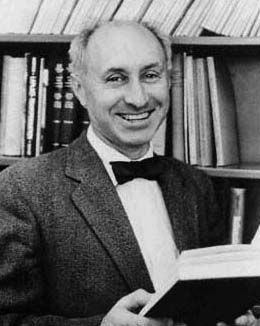


 تاريخ الرياضيات
تاريخ الرياضيات
 الرياضيات في الحضارات المختلفة
الرياضيات في الحضارات المختلفة 
 الرياضيات المتقطعة
الرياضيات المتقطعة
 الجبر
الجبر
 الهندسة
الهندسة 
 المعادلات التفاضلية و التكاملية
المعادلات التفاضلية و التكاملية 
 التحليل
التحليل
 علماء الرياضيات
علماء الرياضيات |
Read More
Date: 22-10-2017
Date: 12-10-2017
Date: 9-11-2017
|
Died: 12 December 1977 in Edinburgh, Scotland

Arthur Erdélyi's father was Ignác József Armin Diamant and his mother was Frieda Roth. One might reasonably ask why Erdélyi's father had the family name Diamant and not Erdélyi. Well Arthur Erdélyi was indeed named Arthur Diamant, but his father died when he was young and his mother remarried. Frieda's second husband adopted Arthur and at that time his name was changed to Erdélyi, the name of his adopted father.
He attended primary and secondary schools in Budapest from 1914 to 1926. His interest in mathematics goes back to this period. As a Jew it was difficult for him to receive a university education in Hungary so he went to Brno, Czechoslovakia, to study electrical engineering. However after winning prizes in a mathematics competition in his first year, he was persuaded to study mathematics. He began research in mathematics and his first paper was published in 1930.
By the end of 1936 Erdélyi had 18 papers in print, another 11 appearing in 1937. Erdélyi wrote no doctoral thesis, he merely matriculated at the University of Prague, and submitted his papers instead of a thesis. He was awarded a doctorate in 1938 but because of the Nazi invasion of Czechoslovakia he was told he had to leave the country by the end of 1938 or be sent to a concentration camp.
Many of Erdélyi's papers were on the hypergeometric function so it was natural for him to write to Whittaker for help. Whittaker found great difficulties in providing the help required: he had to obtain £400 to support Erdélyi before a visa could be obtained. On 26 January 1939 Erdélyi wrote to Whittaker:-
Necessity and danger compel me to trouble you once more. ... You know, perhaps, what it means today if a Jew is to be put on the German or Hungarian frontier.
However within a few days of writing the letter Erdélyi was in Edinburgh. For two years he held a research grant from Edinburgh then he became a lecturer there.
In 1946 Bateman died and Whittaker was asked to recommend someone who could undertake the project of publishing Bateman's manuscripts. Whittaker advised that Erdélyi was the person to undertake the project and in 1947 Erdélyi arrived in Caltech as Visiting Professor. After returning to Edinburgh for session 1948/49 he resigned in 1949 to take up a chair in California.
At Caltech Erdélyi headed a team which produced 3 volumes of Higher Transcendental Functions and 2 volumes of Tables of Integral Transforms. In [3] these works are described as:-
... the most widely cited mathematical works of all time and a basic reference source for generations of applied mathematicians and physicists throughout the world.
In 1964 he returned to Edinburgh where a second chair of mathematics had been created to provide leadership since Aitken was in very poor health. He remained in Edinburgh until his death, continuing to produce a steady stream of high quality papers up to the time of his death. A list of 178 mathematical papers and articles is given in [3].
Erdélyi was a leading expert on special functions, in particular hypergeometric functions, orthogonal polynomials and Lamé functions. He also worked on asymptotic analysis, fractional integration and singular partial differential equations. In addition to the five volumes which arose from the Bateman project mentioned above, Erdélyi wrote two other texts of major importance Asymptotic expansions (1955) and Operational calculus and generalised functions (1962).
Colton in [3] sums up Erdélyi's contribution saying:-
His reputation was based on much more than his published papers, although this alone would have sufficed to make him one of the leading analysts of his day. It was rather a combination of his mathematical scholarship, his interest and enthusiasm for mathematics, his concern for younger workers, and his willingness to devote his time in aid of the mathematical community that won Erdélyi the admiration and respect of an entire generation of mathematicians.
Erdélyi received many honours, the most prestigious being elected a Fellow of the Royal Society in 1975. He had been elected a fellow of the Royal Society of Edinburgh in 1945, receiving their Gunning Victoria Jubilee Prize in 1977, and elected a member of the Academy of Sciences of Turin in 1953.
His contributions are summed up in [2] as follows:-
Erdélyi was a mathematician of immense talent and had a wonderful ability to range over the fields of both pure and applied mathematics. ... His books and research papers together with the achievements of his many research students are a permanent record of the outstanding contribution he made to the subject of mathematics to which devoted his life.
Articles:



|
|
|
|
تفوقت في الاختبار على الجميع.. فاكهة "خارقة" في عالم التغذية
|
|
|
|
|
|
|
أمين عام أوبك: النفط الخام والغاز الطبيعي "هبة من الله"
|
|
|
|
|
|
|
قسم شؤون المعارف ينظم دورة عن آليات عمل الفهارس الفنية للموسوعات والكتب لملاكاته
|
|
|